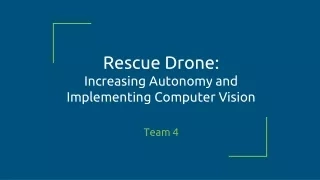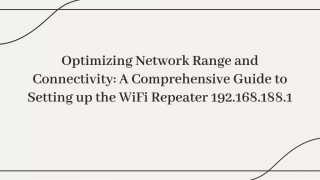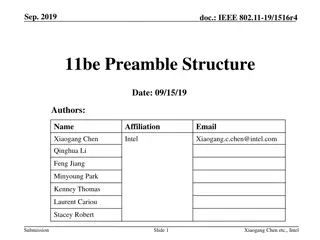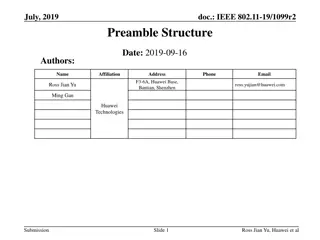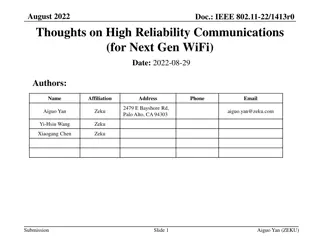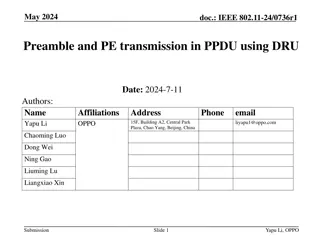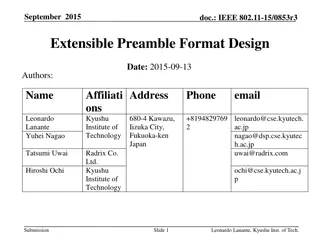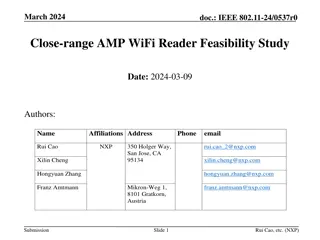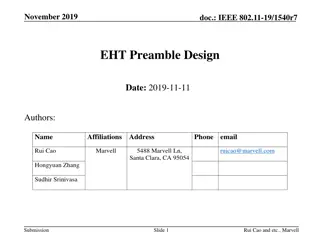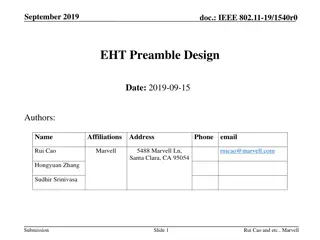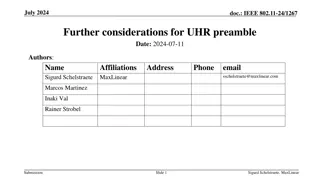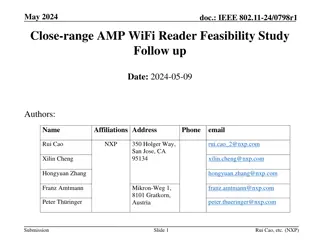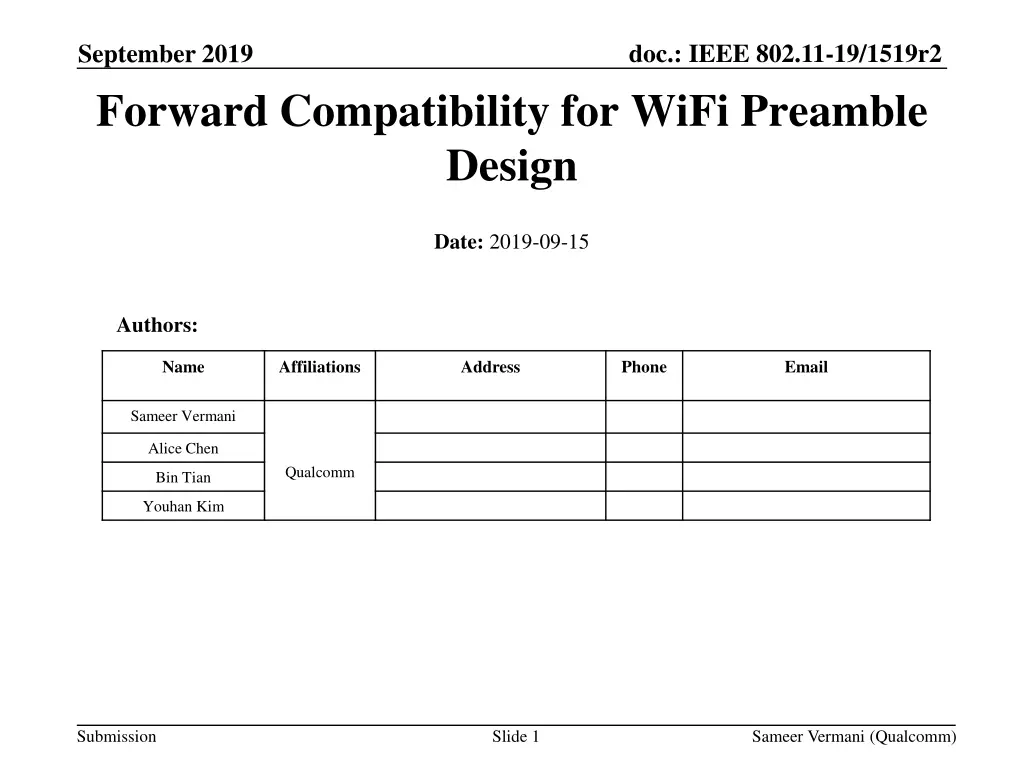
Enhancing Forward Compatibility in WiFi Preamble Design
Explore the concept of forward compatibility in WiFi preamble design, focusing on universal fields to ensure better coexistence among future WiFi generations starting with 802.11be. The proposal aims to address auto-detection issues and improve compatibility beyond traditional backward compatibility approaches. Witness the evolution towards a more sophisticated response from devices, enhancing the overall efficiency and effectiveness of WiFi protocols.
Download Presentation

Please find below an Image/Link to download the presentation.
The content on the website is provided AS IS for your information and personal use only. It may not be sold, licensed, or shared on other websites without obtaining consent from the author. If you encounter any issues during the download, it is possible that the publisher has removed the file from their server.
You are allowed to download the files provided on this website for personal or commercial use, subject to the condition that they are used lawfully. All files are the property of their respective owners.
The content on the website is provided AS IS for your information and personal use only. It may not be sold, licensed, or shared on other websites without obtaining consent from the author.
E N D
Presentation Transcript
doc.: IEEE 802.11-19/1519r2 September 2019 Forward Compatibility for WiFi Preamble Design Date: 2019-09-15 Authors: Name Affiliations Address Phone Email Sameer Vermani Alice Chen Qualcomm Bin Tian Youhan Kim Submission Slide 1 Sameer Vermani (Qualcomm)
doc.: IEEE 802.11-19/1519r2 September 2019 Abstract Traditionally, WiFi preamble design has only focused on backward compatibility These slides are a continuation of the ideas proposed in [1], and propose to bring forward compatibility to WiFi preambles (in the main-stream WiFi bands) starting with 802.11be Desire to solve the auto-detection issue for all future standards starting with EHT, once and for all Better coexistence than just L-SIG based deferral among future generations of 802.11 through universal fields Submission Slide 2 Sameer Vermani (Qualcomm)
doc.: IEEE 802.11-19/1519r2 September 2019 Introduction Historically, 802.11 preambles of every PHY version contain following types of information 1. Information needed by intended receivers E.g., Nss, MCS, Coding etc. 2. Basic Co-existence info for by-standers of previous PHY versions L-SIG duration 3. Richer Co-ex info (medium re-use or power save) for by-standers of current PHY version E.g., BSS Color, UL/DL bit and TxOP fields in 802.11ax Hitherto, information of type 3 is not understood by previous generations E.g., 11ac devices do not understand BSS Color and TxOP in SIG fields of 802.11ax packets Only basic L-SIG duration based co-existence is achieved Better future compatibility starting with 802.11be Richer co-existence among future WiFi versions starting with 11be E.g. 11be devices will respond in a more sophisticated way (compared to just L-SIG based deferral) to the PHY version(s) after that Submission Slide 3 Sameer Vermani (Qualcomm)
doc.: IEEE 802.11-19/1519r2 September 2019 Forward compatibility: Universal Fields (1) Fix the preamble structure across multiple 802.11 generations for at-least a few symbols after legacy preamble Starting with EHT Structure here means the number of OFDM symbols and encoding method Legacy preamble and a Pre-SIG Have some universal fields in the structurally-common preamble section for all standards, EHT and beyond Version independent fields whose presence is independent of the standard version (11be/bf/bg ) All devices compliant with EHT or beyond standards can count on this information being present At a known location in Pre-SIG For example BSS Color, TxOP etc Common structure for EHT and beyond Pre-SIG contains universal fields at certain fixed locations Legacy preamble (may include RL-SIG) 802.11be preamble Pre-SIG Submission Slide 4 Sameer Vermani (Qualcomm)
doc.: IEEE 802.11-19/1519r2 September 2019 Forward compatibility: Universal Fields (2) We think of universal fields as fields satisfying the following properties Presence and location is independent of PHY version Same for 11be/11bf/11bg etc Mainly used for better co-existence among 802.11 generations starting from 11be Should be useful for by-stander devices of multiple generations Based on above, good candidates for universal fields are PHY Format Identifier (Same as PHY Version Identifier proposed in [1]) Value of the format identifier field differentiates between different WiFi versions starting with EHT Auto-detection problem of multiple WiFi generations gets solved together TxOP duration BSS Color UL/DL flag PPDU type (MU/SU/Trigger-based/ER/) may not be a good candidate for universal fields because Every PHY version might have a different set of PPDU types This information is mainly useful for intended receivers and not by-standers Submission Slide 5 Sameer Vermani (Qualcomm)
doc.: IEEE 802.11-19/1519r2 September 2019 Thoughts on the Pre-SIG field -I Common structure for EHT and beyond L-SIG RL SIG Pre- SIG L-STF L-LTF EHT SIG fields Ideally, the universal information should be localized to just the pre-SIG Don t want universal fields to be scattered in multiple parts of the preamble One symbol does not seem to be enough If we have BSS Color (>=6 bits), TxOP (>=7 bits), UL/DL flag and PHY Format Identifier (>=3), adds up to a minimum of 17 bits With CRC (>=4 bits) and 6 bits tail, already exceeds the bit carrying capacity of 1 symbol Three symbols (encoded together) might become a performance bottle neck (in outdoor channels) Two symbols seems to achieve a reasonable balance Submission Slide 6 Sameer Vermani (Qualcomm)
doc.: IEEE 802.11-19/1519r2 September 2019 Thoughts on the Pre-SIG field -II Pre-SIG will be sent on 26 data tones (just like HE-SIG-A) Extra tones will be added to L-SIG and RL-SIG for channel estimation Leaving aside tail and CRC, 2 symbols offer a bit carrying capacity of <=42 bits 42 bits seems like an overkill for universal fields alone Need to manage preamble overhead; can t be profligate with bits in preamble Try to keep extra overhead of 11be to one symbol Can incorporate version dependent fields (e.g. MCS, Nss etc) in the pre-SIG Propose a mix of universal and version-dependent fields in a 2 symbol pre-SIG ER mode (need for which is TBD) may need a longer pre-SIG Common structure for EHT and beyond L-SIG RL SIG Pre- SIG L-STF L-LTF EHT SIG fields 2 symbols jointly encoded. Contains universal and version dependent fields Submission Slide 7 Sameer Vermani (Qualcomm)
doc.: IEEE 802.11-19/1519r2 September 2019 Summary We proposed to bring future compatibility to WiFi preambles starting with 802.11be Solve the auto-detection issue for multiple standards starting with EHT, together Better coexistence than just L-SIG based deferral among future generations of 802.11 Have a structurally common portion of the preamble for multiple WiFi generations starting with 802.11be Legacy preamble followed by a Pre-SIG The Pre-SIG contains universal fields which are version independent Proposed a 2 symbol Pre-SIG with a mix of universal (version independent) and version dependent fields Submission Slide 8 Sameer Vermani (Qualcomm)
doc.: IEEE 802.11-19/1519r2 September 2019 Straw-poll 1 Do you agree with introducing universal fields in the EHT preamble ? The intent of the universal fields is to allow for certain version independent content for better co-existence among future 802.11 generations The exact field definition, location and number of bits are TBD Submission Slide 9 Sameer Vermani (Qualcomm)
doc.: IEEE 802.11-19/1519r2 September 2019 Straw-poll 2 Do you agree to incorporate a PHY format identifier field as one of the universal fields in the EHT preamble? The intent is to simplify auto-detection for future 802.11 generations Size of this field is TBD Submission Slide 10 Sameer Vermani (Qualcomm)
doc.: IEEE 802.11-19/1519r2 September 2019 Straw-poll 3 Do you agree to have a 2 OFDM symbol long, jointly encoded SIG field in the EHT preamble immediately after RL-SIG ? This SIG field will have universal fields Extended Range Mode is TBD The name for this field can be chosen in future based on consensus in the group Submission Slide 11 Sameer Vermani (Qualcomm)
doc.: IEEE 802.11-19/1519r2 September 2019 Straw-poll 4 Do you agree that the SIG field immediately after the RL-SIG will be sent using 52 data tones and 4 pilot tones per-20MHz? Submission Slide 12 Sameer Vermani (Qualcomm)
doc.: IEEE 802.11-19/1519r2 September 2019 Straw-poll 5 Do you agree that the SIG field immediately after the RL-SIG can have some version dependent fields as well? Submission Slide 13 Sameer Vermani (Qualcomm)
doc.: IEEE 802.11-19/1519r2 September 2019 References [1] Sameer Vermani et al, Preamble Design Harmonization , IEEE Document 11/19-1021r1 Submission Slide 14 Sameer Vermani (Qualcomm)

